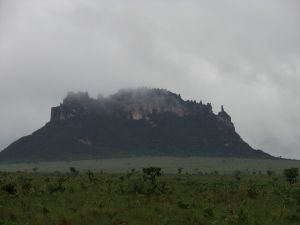
In consideration of the environmental dynamics, it is often found that it is strongly controlled by climatic factors such as atmospheric temperature, rainfall, sunshine, etc.. Similarly, the evolutionof ecosystems and biomes is ruled by climate change incidents in regional, continental and global.
The Cerrado biome, which includes the most significant part of the Ecological Corridor ProjectJalapao Region, Central Brazil is installed for at least 40,000 years and its evolution is occurringin dynamic equilibrium with climate change (Labouriau-SALGADO, 2005).
 At the end of the last glaciation, between 36,000 and 28,000 years before present (BP), in forcein the region humid and relatively cool (Labouriau-SALGADO, 2005; Suguio, 2010). These conditions lasted until 20,000 years BP, as indicated by the absence of pollen of the palmMauritia sp. (buriti). The deglaciation in the Holocene (12,000 years BP) was followed by a longdry spell and hot. These drier conditions than the current ones were until about 7,000 years BP.After 5,000 years BP prevailed a semi-humid climate with a well defined dry season, similar to the current climate. The advent of wetter conditions is evidenced by the development of alluvialand colluvial deposits. Thus, features of lakes, wetlands and trails have become so common in Central Brazil.
At the end of the last glaciation, between 36,000 and 28,000 years before present (BP), in forcein the region humid and relatively cool (Labouriau-SALGADO, 2005; Suguio, 2010). These conditions lasted until 20,000 years BP, as indicated by the absence of pollen of the palmMauritia sp. (buriti). The deglaciation in the Holocene (12,000 years BP) was followed by a longdry spell and hot. These drier conditions than the current ones were until about 7,000 years BP.After 5,000 years BP prevailed a semi-humid climate with a well defined dry season, similar to the current climate. The advent of wetter conditions is evidenced by the development of alluvialand colluvial deposits. Thus, features of lakes, wetlands and trails have become so common in Central Brazil.
Currently prevails in the region studied a climate strongly controlled by equatorial air masses and tropical, with no influence of the mass of tropical maritime. The rains are concentrated in the summer and winter is dry. Overall, 95% of the precipitation during the rainy season focus.Prevailing in the region a hot semi-tropical humid, with about 4 to 5 months of drought. Theaverage temperature stands at around 23 º C and average annual rainfall is defined by theEquatorial Continental regime, especially the months of December and January, with averagesranging from 180mm to 300mm per month. In the rainy season (mid October to May), no record of mean values between 800 and 1,300 mm. In turn, in the dry season (mid-April through September), July is the month that has the lowest rainfall.
The atmospheric temperature in the region are dictated by its continentality, by latitude andtopography. In general, the area has high temperatures and large annual amplitudes, whichreflects its distance from the coast. The largest thermal indices are checked in July andSeptember, with a maximum around 37 ° C. May, June and July are the coldest months. Naturallyoccurring significant local variations (microclimates), conditioned mainly by the relief. For example, there are differences of up to 5 ° C between the averages of the basins of the rivers Tocantins and Parnaíba with the level of the Plain located in the portion of the Rio San Francisco, featured with a transition between humid and semi-humid (RADAMBRASIL, 1982).
On the regional water balance, according to Andrade et al. (2004), the areas under more humid climate records is surplus water during the rainy season. This applies to the northeast portion of Tocantins, where there is water availability during seven months of the year (on average) and a deficit in the remaining months (especially July and August, the height of the drought). The excesswater (water that seeps into surface or in depth, incorporating the drainage network) can reach about 800mm annually on average.